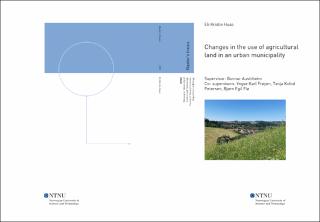| dc.contributor.advisor | Austrheim, Gunnar | |
| dc.contributor.advisor | Frøyen, Yngve Karl | |
| dc.contributor.advisor | Petersen, Tanja Kofod | |
| dc.contributor.advisor | Flø, Bjørn Egil | |
| dc.contributor.author | Huso, Eli Kristin | |
| dc.date.accessioned | 2021-09-25T16:03:17Z | |
| dc.date.available | 2021-09-25T16:03:17Z | |
| dc.date.issued | 2021 | |
| dc.identifier | no.ntnu:inspera:79539604:23118127 | |
| dc.identifier.uri | https://hdl.handle.net/11250/2782487 | |
| dc.description.abstract | Sammendrag
Jordbruksareal er utsatt for press til andre formål enn jordbruk i urbane områder, på grunn av populasjonsvekst og urbanisering. Dette skyldes økt etterspørsel etter areal til boliger, infrastruktur, industri også videre. Men vi har få studier som ser på endringer i arealbruken i bynære områder over lengre perioder, og hva som muligens kan forklare disse endringene. I denne studien undersøkte vi endringer i bruk av jordbruksareal i Trondheim kommune, Sør- Trøndelag fylke og på nasjonalt nivå, i perioden 1969- 2019. Generelle endringer i arealbruk i Trondheim, i perioden 2003- 2019, endringer i bruk av fulldyrka areal og faktorer som kan forklare dette og verifisering av kartdata. Fremtidige planer for omdisponering av fulldyrka jord i kommunen ble undersøkt, og intervjuer av fire aktive bønder som har mista jordbruksareal til forskjellige typer andre formål (mellom 2003 og 2019) ble gjennomført, for å se på deres erfaringer med å drive jordbruk i en voksende by.
Vi fant at mengden jordbruksareal i drift og fulldyrka jord har blitt redusert med mest i kommunen, med henholdvis 22,6 % og 18,9 %. Sammenligna med Sør- Trøndelag (3,7 % og 8,9 %) og Norge (9,5 % og 11,1 %), i perioden 1969 til 2019. I perioden 2003 til 2019 økte mengden bebygd areal med 27,9 % og transport og kommunikasjon (infrastruktur) økte med 29,4 %. Fulldyrka jord gikk ned med 5,6 %.
38 % av den fulldyrka jord har i perioden 2003 til 2019 endret seg til, bebygd areal (og åpen fastmark). Mulige sammenhenger som kan forklare endringer i bruk av fulldyrka jord er befolkningstetthet, avstand til vei og avstand til sentrum. Det meste av den fulldyrka jorda som er planlagt omdisponert, er til bebygd areal, med 48,6 %.
Bønder som mister areal til nedbygging, opplever alle en byrde på grunn av dette, avhengig av hvor stort inngrep dette er for den enkelte bonde. Dette vil avgjøre om, og hvilke justeringer bonden må gjøre, ved å leie jord, nedskalere driften også videre.
Resultatet av denne studien indikerer at tap av jordbruksareal er en svært relevant utfordring i andre byområder så vel som Trondheim, og beslutningstakernes søkelys på tap av jordbruksareal, og hvordan forvalte dette, bør være i byer og urbane kommuner, hvor tapet av jordbruksareal er størst. | |
| dc.description.abstract | Abstract
Agricultural land is exposed to pressure for other purposes than agriculture in urban areas, because of population growth and urbanization. This is due to increased demand for area for housing, infrastructure, industry and so on. But we have few studies that see actual land use changes in peri- urban areas over longer periods of time, and what can possibly explain these changes. In this study we examined agricultural land use changes, in Trondheim municipality, Sør- Trøndelag county, and at national level (in the period 1969- 2019), overall land use changes in Trondheim (period 2003- 2019), changes in use of fully cultivated land and factors explaining this, verification of map data. Future plans for reallocation of fully cultivated land in the municipality was examined, and four interviews of active farmers who lost agricultural area due to development (between 2003 and 2019), were conducted, to look into their experiences of farming in an expanding city.
We found that the amount of agricultural land in operation and fully cultivated land has decreased the most in the municipality, with respectively 22,6 % and 18,9 %. Compared to Sør- Trøndelag (3,7 % and 8,9%) and Norway (9,5 % and 11,1 %), in the period 1969 to 2019. In the period 2003 to 2019 the amount of built-up area increased with 27,9 % and transport and communication (infrastructure) increased with 29,4 %. Fully cultivated land decreased with 5,6 %.
38 % of the fully cultivated land has in the period 2003 to 2019 changed to built-up area (and open firm ground). Possible connections that may explain changes in the use of fully cultivated land are population density, distance to road and distance to the city center. Most of the future plans for reallocation of fully cultivated land is for built-up area, with 48,6 %.
Farmers who lose land for development, all experience a burden of this, depending on how large an intervention this is for the individual farmer. This will determine whether, and what adjustments the farmer must make, by renting land, downscaling operation, etc.
The result of this study implies that loss of agricultural area is a highly relevant challenge in other urban areas as well as Trondheim, and the focus of decision makers, on the reduction of agricultural land, and how to manage this, should be in cities and urban municipalities, where the loss of agricultural land is greatest.
Keywords: land use changes, agricultural area, urbanization, reallocation (demolishing) | |
| dc.language | eng | |
| dc.publisher | NTNU | |
| dc.title | Changes in the use of agricultural land in an urban municipality | |
| dc.type | Master thesis | |
